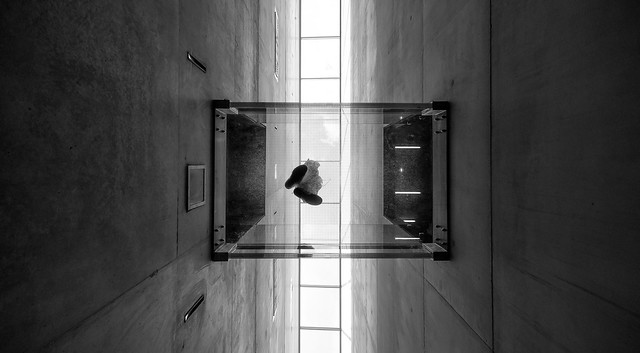Torre David: Informal Vertical Communities edited by Alfredo Brillembourg and Hubert Klumpner, Urban-Think Tank Chair of Architecture and Urban Design, ETH Zürich; photographs by Iwan Baan
Lars Müller Publishers, 2013
Hardcover, 416 pages

Think of "informal housing" and most likely the slums of cities like Mumbai, Lagos, Rio and Caracas come to mind. Built from corrugated metal, CMUs, plastic and other readily available materials, these informal settlements share a condensed, horizontal orientation, following the land they are built upon. But think of vertical versions of the same and only two places come to mind, at least to me:
Kowloon Walled City and
Torre David in Hong Kong and Caracas, respectively. Each construction arose from particular conditions of place and time: KWC evolved over about a century by its occupants, thanks to it being located in an in-between zone separate from Chinese and Hong Kong rule; and the unfinished Torre David was occupied by residents due to a number of factors, including the death of its developer David Brillembourg, a contemporaneous economic crash in Venezuela, and a political leader eager to house all of its country's residents. Now that the residents of Torre David have left the downtown tower, it seems like a good time to look at this book that documents the unique conditions of the place.

["Torre David" installation at 2012 Venice Biennale | Photo by John Hill,
image source]
The book is a result of
Urban Think Tank's (UTT) years spent studying the tower as it evolved from an unfinished part of the skyline to a partially occupied "vertical community," and of Iwan Baan's visual documentation of the place. Their contributions to the project were also made part of the 2012 Venice Architecture Biennale, where Baan's photos were hung on brick walls that echoed those built by residents to "complete" the unfinished tower's exterior walls, and a cafe turned the middle of the Arsenale into a bustling spot. Curator Justin McGuirk, who has just written his own book,
Radical Cities, on Torre David and other settlements in Latin America, transplanted the essence of Torre David – the improvisation, the materials, the vitality – to Venice. The Biennale jury was impressed enough to award it the Golden Lion for the Best Project of the International Exhibition
Common Ground.

[The unfinished 45-story tower is the third tallest in Caracas | Photo by Iwan Baan,
image source]
In order to convey the qualities of the place without the benefit of creating a space that can be occupied temporarily, the book relies on Baan's photographs to a great deal, as well as UTT's descriptions and drawings. Both are necessary to understand the extents of the construction (Torre David, for example, is actually made up of multiple buildings, not just one tower), the layout of the informal residences, how services are integrated into the unfinished building, and how people have improvised homes in 28 of the tower's 45 floors. To put it another way, where the drawings describe the place, the photograph's describe the lives within the place. In this sense, the two means of visualization are necessary to each other.

[A basketball court has been inserted in the gap between the tower and the parking garage | Photo by Iwan Baan,
image source]
It's important to note that UTT's efforts weren't limited to capturing Torre David and its residents as a situation, nor were they interested in promoting the residents' efforts as the ideal. UTT made proposals for making the settlement permanent, focused primarily on sustainability, so that all of the tower's floors could be used and each resident would have safe access to water and power. But as recent news has made clear, the squatter's lives inside Torre David were numbered. Initial rumors indicated that a Chinese bank bought the building and thereafter evicted the residents, with the goal of restoring the building to its original function as an office building and bank center. Yet other reports say the buildings will be torn down and replaced with cultural buildings. Whatever the case, most of the roughly 1,000 families have been moved to new housing outside of Caracas.

[Only one stair is available for ascending the tower | Photo by Iwan Baan,
image source]
That the book/exhibition/project did not result in getting the residents and city to work together to make this iteration of Torre David more permanent does not mean the book is meaningless. Far from it. The book's greatest value – much like Greg Girard's and Ian Lambot's great book,
City of Darkness, on KWC – is to break down the myths of the place (that it's crime-ridden, unsafe, etc.) and describe to readers how it
really worked. That Torre David had security guards on the ground floor, a community hierarchy of leadership, community services within the building, small business catering to transit and other needs (the list goes on), shows that there was a great deal of organization in the seemingly chaotic and improvisatory creation. Those traits, to a greater or lesser degree, will follow in the families new homes, even as the circumstances will be very different.

[Inside one of the units in the tower | Photo by Iwan Baan,
image source]
























![Stadshal Gent [9]](https://farm6.staticflickr.com/5551/14563056930_8c5452327b_z.jpg)
![Stadshal Gent [4]](https://farm6.staticflickr.com/5567/14726733566_2b6a5dfccb_c.jpg)
![Stadshal Gent [1]](https://farm4.staticflickr.com/3914/14749723045_83461bfc4e_z.jpg)
![Stadshal Gent [5]](https://farm6.staticflickr.com/5557/14747382924_41c9c98236_c.jpg)
![Stadshal Gent [3]](https://farm6.staticflickr.com/5591/14769594663_0e3fc7dee2_z.jpg)
![Stadshal Gent [6]](https://farm3.staticflickr.com/2903/14746559881_9fffd6448d_z.jpg)
![Stadshal Gent [7]](https://farm4.staticflickr.com/3861/14563089418_014205ca49_z.jpg)
![Stadshal Gent [8]](https://farm6.staticflickr.com/5575/14563083489_0ba6d79895_c.jpg)

